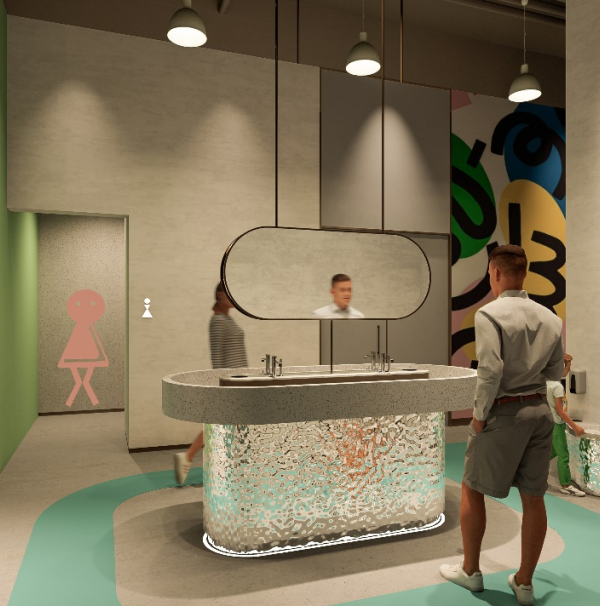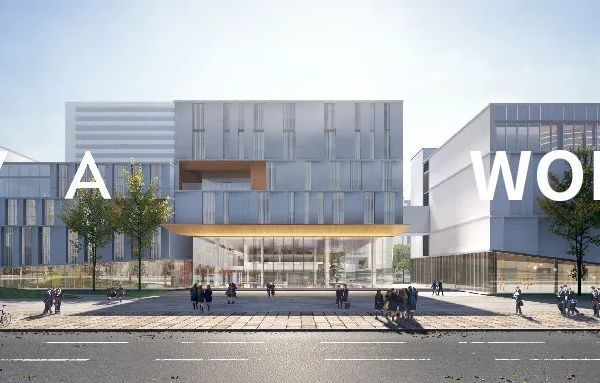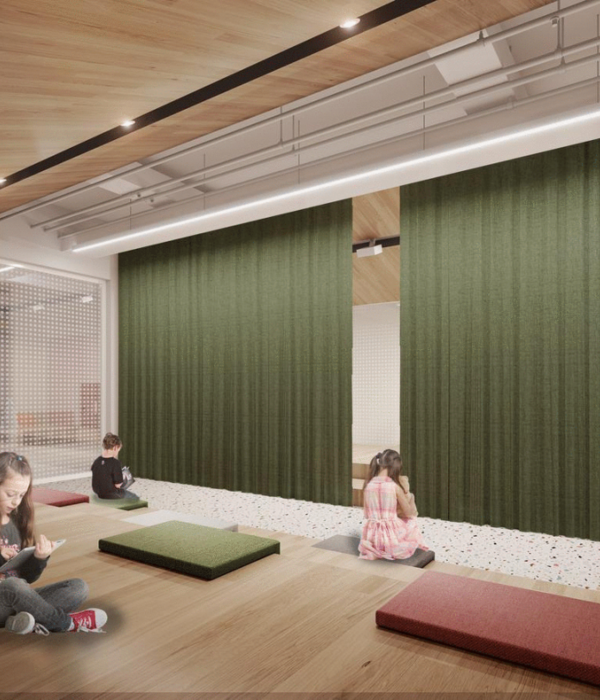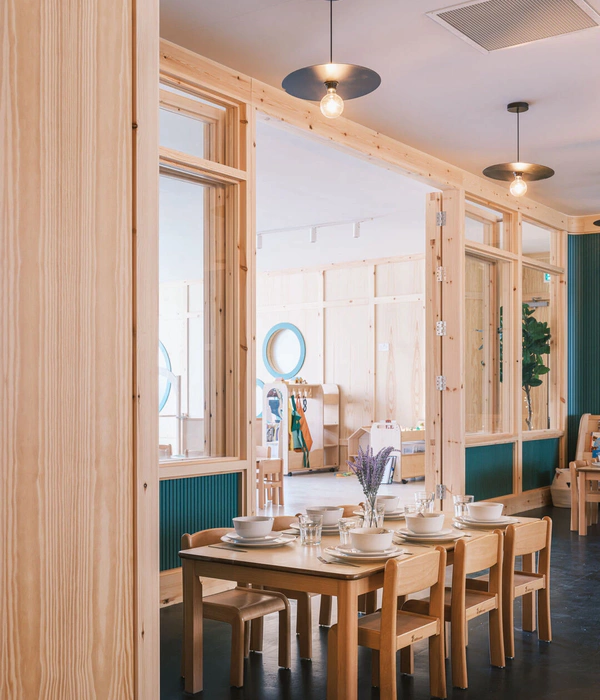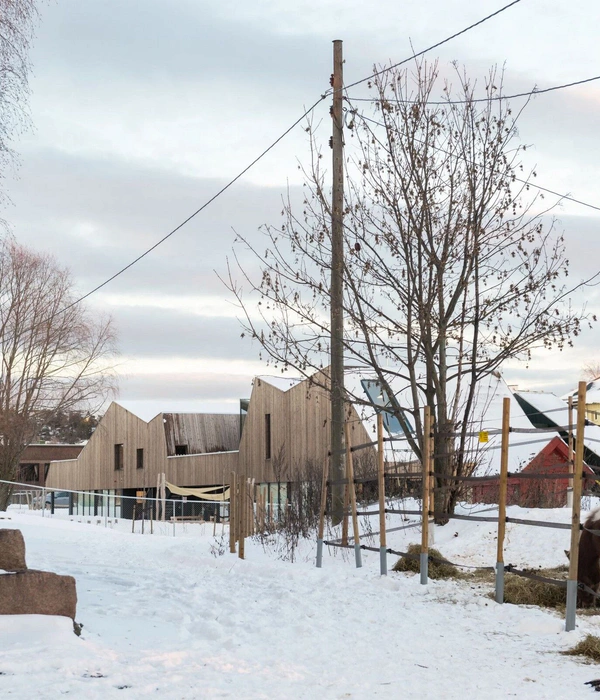这座占地9.5万平方米的建筑位于挪威生命科学大学(NMBU)奥斯校区,汇集了兽医医学研究设施和教学空间,是欧洲最先进的兽医建筑之一。对理解自然界的渴望一直是人类创新的核心,但随着全球化加速我们与世界之间的相互影响,这种渴望越发迫切。奥斯校区的新兽医大楼基于这种迫切,于2021年秋季正式开放。据悉,该楼是挪威最大规模的大学和学院综合开发项目。
The 95,000 m2 building, located at the Norwegian University of Life Sciences (NMBU)’s Campus Ås, brings together both research facilities and teaching space for veterinary medicine – one of the most advanced veterinary buildings in Europe. The desire to understand the natural world has always been at the heart of human innovation but has gained critical urgency as globalism accelerates the cycle between our impact on the world and the world’s impact on us. The new Veterinary Building at Campus Ås, officially opened in the fall of 2021, was conceived with this cycle in mind. It is the largest overall development in the university and college sector in Norway ever.
▼项目鸟瞰,aerial view ©Einar Aslaksen
“这是一座具有先驱意义的校园,”在项目设计和施工过程中发挥重要作用的Henning Larsen奥斯陆办公室部门主管Karoline Igland说道,“世界上任何地方都没有这样一座建筑,能够将业界研究人员和专家联合起来,并在安全与准备方面有相同的要求标准。该项目不仅是技术先进和高度安全的设施,而且为师生提供了一个开放舞台。该项目所呈现出的结果经历了十年的合作、研究与创新。”奥斯校区的兽医大楼实际上是八座不同但相互联系的建筑,将以前分散的资源(其中一些在奥斯陆,位于NMBU主校区以北30公里处)结合在一起。该项目是Statsbygg与Multiconsult、Fabel Arkitekter、Link Arkitektur、Erichsen + Horgen合作开发的,是挪威有史以来规模最大的、最复杂的建筑项目之一。
“It is the first campus of its kind,” says Karoline Igland, Head of Department at Henning Larsen’s Oslo office, who has played a major role in the project throughout the design and construction. “No building anywhere in the world unites the same range of researchers and experts or has the same requirements in terms of safety and readiness. In addition to being a technically advanced and highly secure facility, it also needed to be an open arena for students and faculty. The result you see today has required ten years of collaboration, research, and innovation.” The Veterinary Building at Campus Ås is in fact eight distinct but linked buildings, uniting previously disparate resources (some of which were in Oslo, 30km to the north of NMBU’s main campus.) Developed for Statsbygg in cooperation with Multiconsult, Fabel Arkitekter, Link Arkitektur, and Erichsen + Horgen, the project is one of the largest and most complex construction projects ever undertaken in Norway.
▼总体规划,master plan ©Henning Larsen
融入、脱颖而出
奥斯校区后面的老旧建筑曾经是挪威农业科学大学,坐落在开阔的山丘景观中,兽医大楼绵长而低矮的外形使其既融入校园环境又脱颖而出。新兽医大楼位于有植物、鲜花和开放水道的美丽公园内,其颜色与校园里的古建筑相匹配。建筑立面由30多万块手工切割的砖块组成,每块砖都是用煤烧制的,使其呈现出独特的光泽和质感。砖的红褐色色调与周围的校园建筑相衬,其中一些建筑可以追溯至1859年校园成立之初。建筑周围围绕着本土植物,屋顶上的景天属植物为昆虫提供了繁茂的栖息地。
Behind the venerable original building on what was previously known as the Norwegian University of Agricultural Sciences on Ås, situated in an open landscape of soft hills, the long and low profile of the Veterinary Building at Campus Ås allows it to fit in to its campus surroundings while still standing out. In a beautiful park with plants, flowers and open waterways is the new Veterinary Building, matched in color to the antiquarian buildings on campus. The façade is built up of over 300,000 hand-cut bricks, each coal fired to give them an individual sheen and texture. The reddish-brown hue of the bricks also matches the surrounding campus structures, some of which date back to the campus’ foundation in 1859. Native plantings surround the bulk of the new building and can also be found up above, where sedum roofs support a prosperous insect habitat.
▼新建筑的红褐色色调与旧建筑相称,the reddish-brown hue of the new building matches the old building ©Einar Aslaksen
▼庭院绿化,courtyard greening ©Einar Aslaksen
▼立面细部,facade detail ©Einar Aslaksen
肩负使命的建筑
如何设计世界级的研究和学习设施,使人和动物能够在潜在的传染性和危险环境中共存?挪威政府提出要成为在生物安全和传染病传播方面的教研领先国家之一,而挪威生命科学大学的新兽医大楼就是为了实现这一目标而设计的。该项目拉近了巨大与渺小、危险与安全、临床与人类、孤立与联系之间的距离,在9.5万平方米的建筑面积中容纳了2400多个房间,尽管整体规模庞大,但内部使用感仍是舒适的。这座建筑几乎不超过四层,八个侧翼分布在挪威兽医研究所和挪威生命科学大学两个建筑主体之间。
How do you design world-class research and learning facility, where people and animals can co-exist in a potential infectious and hazardous environment? The Norwegian government has set out to become one of the leading nations in education and research in biosafety and the spread of infectious diseases, and the new Veterinary Building at the Norwegian University of Life Science is designed to fulfil this ambition. The project is a bridging of gaps between great and small, hazardous and safe, clinical and human, isolated and connected. Despite its vast scale, which packs over 2,400 rooms into the building’s 95,000 m2 of floorspace, the interiors at the Veterinary Building at Campus Ås feel almost cozy. The building rarely rises over four stories and is subdivided into eight wings which are themselves distributed between the building’s two primary programs: the Norwegian Veterinary Institute and the Norwegian University of Life Science.
▼建筑外观,exterior view ©Einar Aslaksen
▼宜人的楼层尺度,pleasant floor scale ©Einar Aslaksen
兽医大楼的传染病研究实验室和手术室(以及相应后勤空间)等高度敏感甚至有风险的空间都封闭在大楼中心,由环绕在建筑外部的公共项目构成的可渗透屏障保护起来。这一区域可以被分为更小的模块,如果需要,可以单独封闭,而不是让整个设施永久封锁,因此学生和访客也可以直接进入大楼中心,无需承担建筑功能固有的风险。
“奥斯校区的设施设计独特而全面,”Karoline Igland解释道,“只有当我们分享知识和共同努力时,才能实现突破。该校区融合了高度技术和社交空间,促进了这种合作。”
The highly sensitive and even hazardous spaces the campus houses, such as the Veterinary Building’s laboratories for infectious disease research and surgical suites (and corresponding logistical spaces), are bound in the center, protected by a permeable barrier of public program that rings the campus’ exterior. Students and university visitors can venture almost all the way into the heart of the building without experiencing the risk intrinsic to the building’s function it is broken into smaller modules that can be individually locked down if needed rather than putting the entire facility on perpetual lockdown.
“The breadth of facilities at Campus Ås is unique and comprehensive by design,” explains Karoline Igland. “Breakthroughs happen when we share knowledge and work together, and Campus Ås combines both the highly technical and social spaces that foster those kinds of cooperations.”
▼实验室,laboratory ©Einar Aslaksen
▼手术室,surgical suites ©Einar Aslaksen
世界一流的研究设施和开放的学习环境合二为一
学习地点会对人吸收和记忆知识的能力产生巨大影响。近年来的研究(包括Henning Larsen博士研究人员Krister Jens的研究)表明,高等教育设施内的非正式空间和社交空间可以在学习和创新方面产生可衡量的结果。奥斯校区兽医大楼的互联结构正是考虑到这一点,在马厩、水族馆、动物诊所、水疗池、骑马厅、BSL 3 实验室、尸检室、教室、办公室、图书馆和食堂之间,社交空间为研究人员、教师、学生和访问专家提供了正式和非正式会面以及相互学习的空间。
Where you learn can have a tremendous effect on your ability to take in and retain knowledge. Research in recent years (including that of Henning Larsen PhD researcher Krister Jens) has shown that informal and social spaces within higher education facilities can have measurable outcomes in learning and innovation. The interlinked structures of the Veterinary Building at Campus Ås function with this in mind: between the stables, aquariums, animal clinics, hydrotherapy pools, riding halls, BSL 3 laboratories, autopsy rooms, classrooms, offices, libraries, and canteens, social spaces make room for researchers, faculty, students, and visiting experts to meet and learn from each other – both formally and informally.
▼中庭,atrium ©Einar Aslaksen
▼开放的学习环境,open learning environment ©Einar Aslaksen
研究/临床领域的情况也同样复杂,比起方便人们进行会面,这里更需要将不同空间进行严密分隔,以避免交叉污染。甚至动物也必须根据小型和大型进行分隔,并以健康/受伤和生病的标准进行进一步区分。
Things are no less complex in the research/clinical areas where, rather than facilitating casual meetings between people, different spaces must be carefully separated to avoid cross contamination. Even the animals must be carefully separated, with veterinary program divided between small and large animal clinics and subdivided further to separate healthy/injured animals from those that are ill.
▼走廊,corridor ©Einar Aslaksen
▼大型动物区,large animal area ©Einar Aslaksen
奥斯校区的新兽医大楼于2021年9月1日正式开放,可容纳700名学生和近1000名员工。
The new Veterinary Building at Campus Ås officially opened on 1 September 2021 for 700 students and almost 1.000 employees.
▼剖面图,section ©Henning Larsen
Location: Ås, Norway
Client: Statsbygg
User group: Faculty of Veterinary Medicine at the Norwegian University of Life Sciences, The Norwegian Veterinary Institute
Gross floor area: 63,000 m2
Construction period: 2013 – 2021
Project team: Multiconsult, Henning Larsen, Fabel Arkitekter, Link Landskap and Erichsen & Horgen
{{item.text_origin}}


